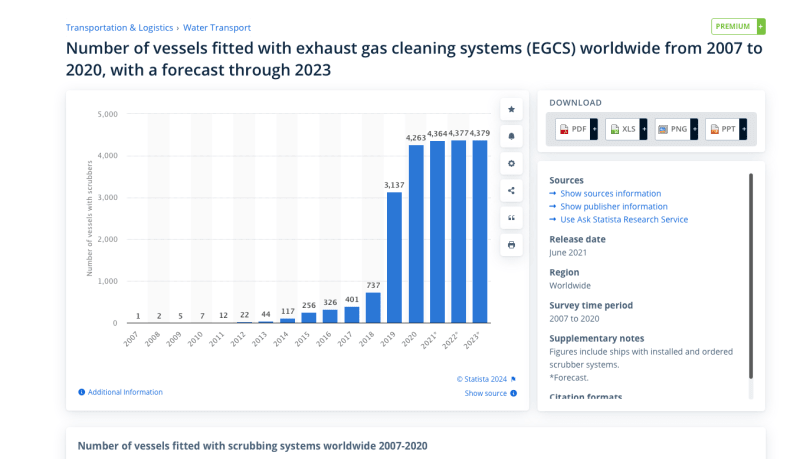Navigation
Install the app
How to install the app on iOS
Follow along with the video below to see how to install our site as a web app on your home screen.
Note: This feature may not be available in some browsers.
More options
Style variation
-
Congratulations TugboatEng on being selected by the Eng-Tips community for having the most helpful posts in the forums last week. Way to Go!
You are using an out of date browser. It may not display this or other websites correctly.
You should upgrade or use an alternative browser.
You should upgrade or use an alternative browser.
Baltimore Bridge collapse after ship collision 125
- Thread starter Tomfh
- Start date
- Status
- Not open for further replies.
Marine scrubbers exist only to strip Sulfur gas from ship exhaust. The clip below is one closed loop version. There are also open loop versions.
It may be that one scrubber serves more than one engine. That would explain the dampers as they
would be necessary to keep exhaust gas from an on line engine from backing up into an off line engine. If the arrangement is relevant to the accident story eventually the NTSB report will provide a description of the arrangement used on the Dali.
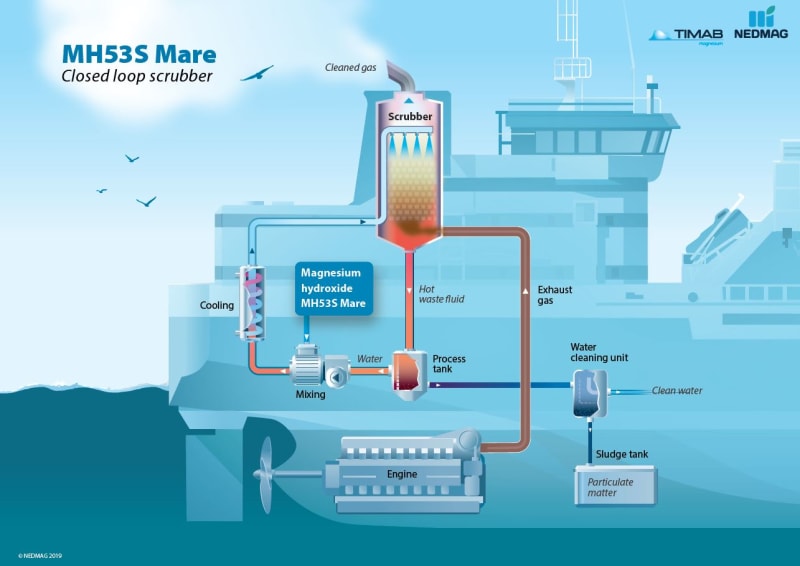
It may be that one scrubber serves more than one engine. That would explain the dampers as they
would be necessary to keep exhaust gas from an on line engine from backing up into an off line engine. If the arrangement is relevant to the accident story eventually the NTSB report will provide a description of the arrangement used on the Dali.

The FBI was brought in to conduct a criminal investigation, after our Administrative State claimed no foul play.
Point being anything that would affect the FBI’s criminal investigation, will likely be with held from NTSB’s report till the criminal process plays out.
Marine Insight says this about exhaust gas bypass for individual engines:
"An exhaust gas bypass valve is also installed for the individual engines to bypass the scrubber in the case of an emergency."
So loss of power to scrubber would warrant by passing it for all engines. So loss of power and scrubber bypass could explain black smoke too. Container ships seemed to have jumped on scrubber band wagon and as means to run cheaper fuels all the time......
“What Is a Marine Scrubber?
A scrubber is an exhaust gas cleaning system that removes particulate matter and harmful substances, such as sulfur oxide (SOx) and nitrogen oxide (NOx), from exhaust gas streams emitted by ships.”
Point being anything that would affect the FBI’s criminal investigation, will likely be with held from NTSB’s report till the criminal process plays out.
Marine Insight says this about exhaust gas bypass for individual engines:
"An exhaust gas bypass valve is also installed for the individual engines to bypass the scrubber in the case of an emergency."
So loss of power to scrubber would warrant by passing it for all engines. So loss of power and scrubber bypass could explain black smoke too. Container ships seemed to have jumped on scrubber band wagon and as means to run cheaper fuels all the time......
“What Is a Marine Scrubber?
A scrubber is an exhaust gas cleaning system that removes particulate matter and harmful substances, such as sulfur oxide (SOx) and nitrogen oxide (NOx), from exhaust gas streams emitted by ships.”
TugboatEng
Marine/Ocean
There was talk about work being done on the ship prior to departure but these described failures should not cause the low voltage transformer breakers to trip.
Remember, the scrubber bypassed are installed and documented. The scrubbers are only used in specific regions and spend most of their time bypassed, legally.
Remember, the scrubber bypassed are installed and documented. The scrubbers are only used in specific regions and spend most of their time bypassed, legally.
LittleInch
Petroleum
Ooops409,
This is what the NTSB says
"While working on the diesel engine exhaust scrubber system for the
diesel engine driving the only online generator (generator no. 2), a crewmember
mistakenly closed an inline engine exhaust damper. Closure of this damper
effectively blocked the engine’s cylinder exhaust gases from traveling up its stack and
out of the vessel, causing the engine to stall."
Now we have also found out that the EG which I can only assume kicked in only powers the fuel pump for the no2 generator....[I'm sure I read this somewhere and it kind of makes sense but can't lay my hands on it. Hence why DG2 came back on line when in port and when DG3 and 4 failed when sailing due to loss of fuel pressure.]
Hence when no 3 started it had no fuel pump working and then ran out of fuel pressure before the 440V system came back on line and the fuel pumps restarted.
Remember - More details = better answers
Also: If you get a response it's polite to respond to it.
This is what the NTSB says
"While working on the diesel engine exhaust scrubber system for the
diesel engine driving the only online generator (generator no. 2), a crewmember
mistakenly closed an inline engine exhaust damper. Closure of this damper
effectively blocked the engine’s cylinder exhaust gases from traveling up its stack and
out of the vessel, causing the engine to stall."
Now we have also found out that the EG which I can only assume kicked in only powers the fuel pump for the no2 generator....[I'm sure I read this somewhere and it kind of makes sense but can't lay my hands on it. Hence why DG2 came back on line when in port and when DG3 and 4 failed when sailing due to loss of fuel pressure.]
Hence when no 3 started it had no fuel pump working and then ran out of fuel pressure before the 440V system came back on line and the fuel pumps restarted.
Remember - More details = better answers
Also: If you get a response it's polite to respond to it.
What could possibly go wrong with scrubber retrofit integration into a container ship?
I have no idea of the interlocks and protection mechanisms built into the control system, or how they provided power to the retrofitted scrubber. Perhaps it was not hooked to the EG buss because as has been said, EG was not MAN enough for that additional load. Black smoke may just be an effect of loss of power, and nothing more than that.
I have no idea of the interlocks and protection mechanisms built into the control system, or how they provided power to the retrofitted scrubber. Perhaps it was not hooked to the EG buss because as has been said, EG was not MAN enough for that additional load. Black smoke may just be an effect of loss of power, and nothing more than that.
TugboatEng
Marine/Ocean
I believe what you have demonstrated with that video is that there are no scrubbers on the generator exhausts.
Nukeman948
Electrical
TugboatEng (Marine/Ocean) said:I believe what you have demonstrated with that video is that there are no scrubbers on the generator exhausts.
Actually that video is a different ship so he demonstrated nothing.
The Dali is new enough that it may have been designed with scrubbers so any speculating on a bad retrofit with zero (or misleading) evidence to support his accusations is just wasting our time.
Nukeman948......... said:Actually that video is a different ship so he demonstrated nothing.
The Dali is new enough that it may have been designed with scrubbers so any speculating on a bad retrofit with zero (or misleading) evidence to support his accusations is just wasting our time.
I believe it was reported that Hyundai was the OEM Manufacture of the Dali.
Since some folks do NOT do their own research or thinking, and assuming they know what I am thinking. I wonder if they even know when the Dali was built?
Jan 11, 2018 was when the first two scrubbers retrofitted to two (2) Brand NEW ships.........
"The retrofitting was done after the ships were first delivered to HMM last August from Subic-based Korean shipbuilder Hanjin Heavy Industries & Construction in the Philippines."
“The HMM Promise is the world’s first commercially operating mega container vessel of more than 11,000 TEUs equipped with a large scrubber system,” said an HMM official. It also features an engine designed to save fuel while ensuring optimal economic speed and performance."
"Originally ordered by Greek-based Oceanbulk Container Carriers in 2014, the ships were transferred to HMM as part of a resale transaction in 2017, according to data provided by VesselsValue."
Nukeman948
Electrical
Oops409 said:some folks...
Attacking a person's character is weak.
1991 for the first prototype scrubber on board a ship:
Five years before your date and two years before Dali was built:
I found plenty more examples.
My research was inconclusive on the specifics for Dali but if the designers and engineers who built it couldn't look ahead and include scrubbers or at least provisions for future modifications then they really dropped the ball. Anyone could see that tougher regulations were coming.
Any scrubber retrofit will need extensive engineering to ensure all regulations are met and documented for compliance in all ports they may visit. It's not just a kit you order from Amazon and install on a weekend without verifying that it performs correctly and without compatibility issues with other systems. MY thinking is that proper engineering would not question if the emergency generator was MAN enough because scrubbers wouldn't be required in an emergency.
Still waiting for evidence specific to the Dali, not HMM Promise or any other ships or manufacturers...
Nukeman948
Electrical
You can't prove a negative.
Out of the 117 ships launched in 2014 that did have scrubbers, how many were named Dali?
You're wasting our time.
Out of the 117 ships launched in 2014 that did have scrubbers, how many were named Dali?
You're wasting our time.
-
1
- #452
TugboatEng
Marine/Ocean
Nukeman, emissions regulations apply broadly to all ships under IMO. USA has stricter rules under EPA and Air Resource Boards. All ships entering control zones are required to follow the same set of rules. Scrubbers are only not required if the ship operator chooses to burn low sulfur fuels. Here in California I see ships built in the early 1980's with retrofitted scrubbers. The stacks on the retrofitted ships are comically large.
After and before:
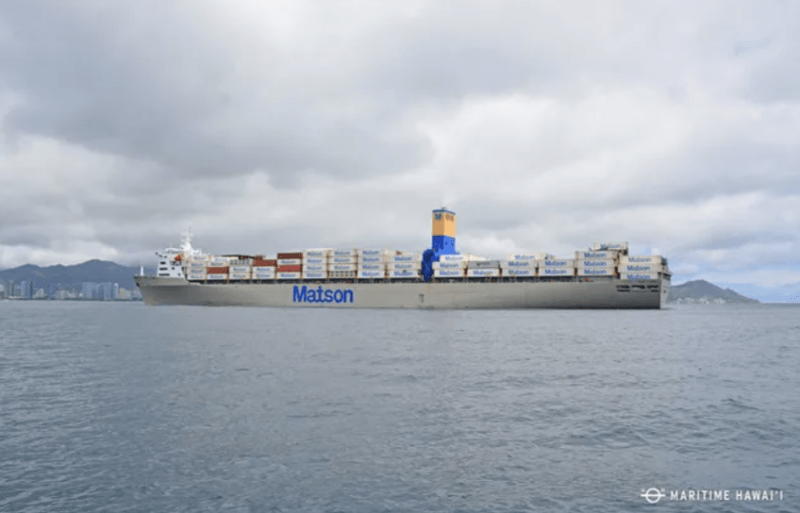
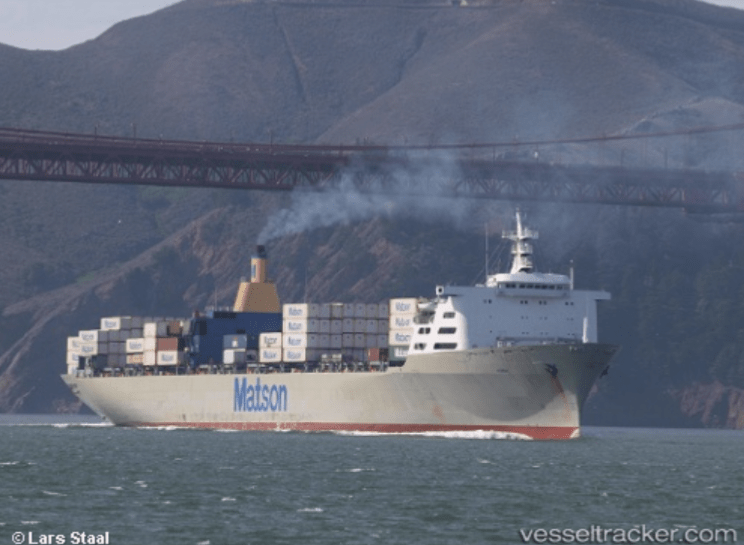
After and before:


I tried to follow but some go on for pages and still no firm conclusions drawn.
TugboatEng
Marine/Ocean
GCaptain removed all of their intelligent members years ago under the guide of political correctness. Apparently it's not ok to talk like a sailor on a forum for sailors. I haven't returned since c.captain was removed.
It was quite the dramatic departure.
John Konrad turned the website into the same corporate newsletter every other maritime publication is.
It was quite the dramatic departure.
John Konrad turned the website into the same corporate newsletter every other maritime publication is.
-
1
- #456
Nukeman948
Electrical
TugboatEng said:The stacks on the retrofitted ships are comically large.
Thanks Tug.
That is actually strong evidence that the scrubber was a retrofit. By looking at the actual ship in question in old pictures it looks like the extra equipment was added to the starboard side of the stack.
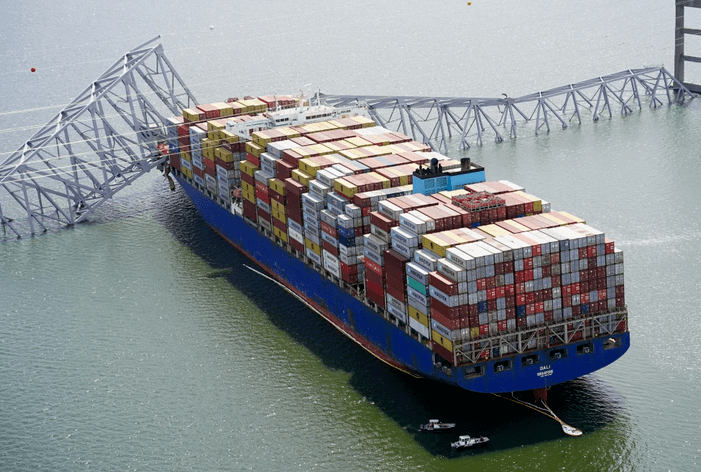
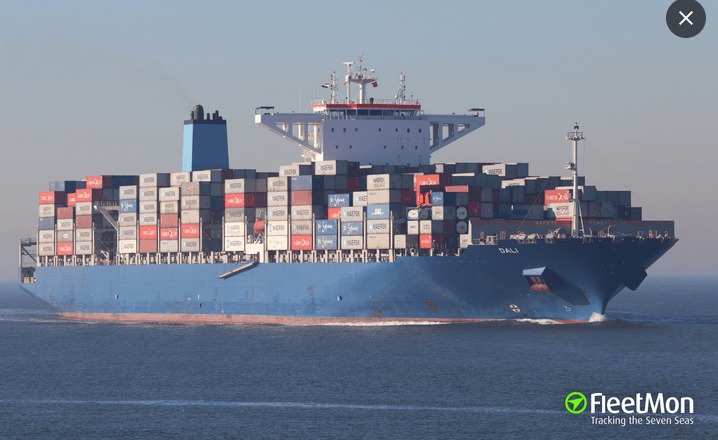
Perhaps we can now get an explanation on why this was so important.
Deadrise Marine Photography (Facebook) has posted photos of ongoing work peeling the road deck off the Dali.
JohnRBaker
Mechanical
A milestone has been reached:
Baltimore shipping channel fully reopens after massive cleanup
“When we work together, we can actually get big things done,” said Maryland Gov. Wes Moore (D).
An excerpt from the above item:
After a colossal cleanup effort, federal and state authorities fully reopened the main shipping channel to the Port of Baltimore on Monday, transforming a site of ferocious destruction into a symbol of resilience after an errant container ship downed the Key Bridge in March and killed six workers.
Authorities restored the federal channel to its original 700-foot width and 50-foot depth, providing a moment of hope after a painful period in Baltimore.
“Yet again, Baltimore was counted down and out,” Mayor Brandon Scott (D) said in an interview. “And yet again, Baltimore proved the world wrong.”
Disruptions from the March 26 bridge collapse have cost the Baltimore region’s economy about $1.2 billion, said Anirban Basu, an economist with the Sage Policy Group Inc., a Baltimore-based consulting firm. That takes into account a sharp drop in port activity immediately after the disaster and more moderate losses as smaller channels kept a reduced quantity of goods flowing — as well as all the spending on clearing the channel itself.
John R. Baker, P.E. (ret)
Irvine, CA
Siemens PLM:
The secret of life is not finding someone to live with
It's finding someone you can't live without
Baltimore shipping channel fully reopens after massive cleanup
“When we work together, we can actually get big things done,” said Maryland Gov. Wes Moore (D).
An excerpt from the above item:
After a colossal cleanup effort, federal and state authorities fully reopened the main shipping channel to the Port of Baltimore on Monday, transforming a site of ferocious destruction into a symbol of resilience after an errant container ship downed the Key Bridge in March and killed six workers.
Authorities restored the federal channel to its original 700-foot width and 50-foot depth, providing a moment of hope after a painful period in Baltimore.
“Yet again, Baltimore was counted down and out,” Mayor Brandon Scott (D) said in an interview. “And yet again, Baltimore proved the world wrong.”
Disruptions from the March 26 bridge collapse have cost the Baltimore region’s economy about $1.2 billion, said Anirban Basu, an economist with the Sage Policy Group Inc., a Baltimore-based consulting firm. That takes into account a sharp drop in port activity immediately after the disaster and more moderate losses as smaller channels kept a reduced quantity of goods flowing — as well as all the spending on clearing the channel itself.
John R. Baker, P.E. (ret)
Irvine, CA
Siemens PLM:
The secret of life is not finding someone to live with
It's finding someone you can't live without
JohnRBaker
Mechanical
I just read an item which stated that the original estimate was that it would take a minimum of six-months to clear the channel into Baltimore's harbor after the Francis Scott Key bridge collapse, but that it was reopened this past Monday, after only 11-weeks. Now it'll still be a couple of years probably before the bridge is rebuilt/replaced, but at least the port has been reopened to normal maritime traffic.
John R. Baker, P.E. (ret)
Irvine, CA
Siemens PLM:
The secret of life is not finding someone to live with
It's finding someone you can't live without
John R. Baker, P.E. (ret)
Irvine, CA
Siemens PLM:
The secret of life is not finding someone to live with
It's finding someone you can't live without
- Status
- Not open for further replies.
Similar threads
- Replies
- 13
- Views
- 13K
- Question
- Replies
- 39
- Views
- 21K
- Replies
- 17
- Views
- 11K
- Replies
- 25
- Views
- 25K
- Replies
- 33
- Views
- 3K

